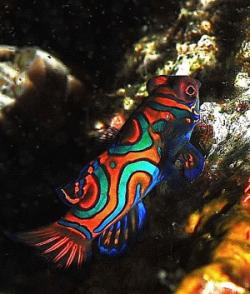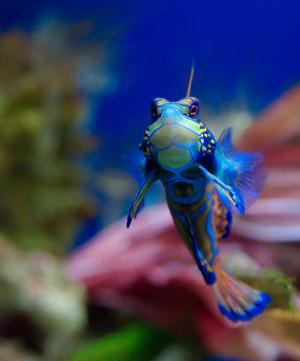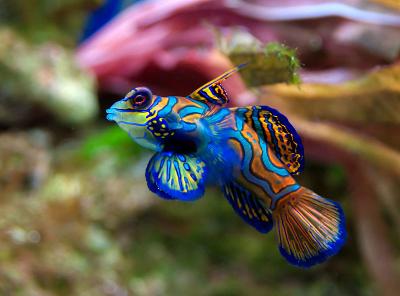Mandarinfish (Dragonet)
Mandarinfish (Synchiropus splendidus) are small, very colorful fish that inhabit the coral reefs of the western Pacific. Mandarinfish are also commonly referred to as mandarin gobies or mandarin dragonets.
The name "mandarinfish" is derived from their colorful pattern, which is said to resemble the robes of a Chinese mandarin.
Mandarinfish are scaleless, very colorful, highly patterned fish. They belong to the family Callionymidae, which is a small family of fishes commonly referred to as dragonets and mandarinfish.

Photo by Jenny Huang
They are bottom dwelling fish, that despite their colorful pattern, are well camouflaged in the colorful reef environment. Mandarinfish also secrete a toxin in the mucous that covers their bodies that is toxic to some predators.
Tankmate Compatability
Mandarinfish are compatible with most fish, however, you shouldn't keep them with angelfish (dwarf species of angelfish are okay) or groupers. Also, use caution when keeping more than one mandarin fish in your tank. You can keep a male and female mandarinfish together, but don't try to keep two males or they will probably fight in the small confines of the aquarium. However, in their natural habitat mandarinfish are typically seen in small groups.
Sexing mandarinfish isn't too difficult, because males usually have an elongated, pointed dorsal fin as shown in the image below. Females are also usually smaller than the males. They sometimes spawn in captivity. In their natural environment spawning takes place in the water column where the female produces floating eggs.
Generally, mandarinfish are peaceful fish that shouldn't be kept with agressive species or fish large enough to eat them. Mandarinfish only reach an adult size of between 2.5-3 inches (6-7.6 cm) in length.
They are shy fish that need plenty of hiding places. Provide them with plenty of rockwork and caves. Also, you don't want to keep them with lots of other bottom-dwelling fish with whom they must compete for food and hiding places.
Also use caution when keeping them with anemones because they have been known to eat mandarinfish.
Mandarinfish Diet
Mandarinfish are good reef inhabitants and they feed on the small crustaceans found there. You should provide plenty of live rock and sand for them to feed on. In fact, they usually don't survive long in captivity unless they have access to well-established live rock. Don't try to keep them in a newly set up tank because they won't have enough to eat.
They are omnivores, eating both plant and animal based foods. In addition to the living crustaceans on the well-established live rock and sand you should provide them with algae. They can also be fed newly hatched brine shrimp and other frozen foods for marine fish.
As pretty and interesting as mandarinfish are you'd think they'd be really expensive, but they can typically be purchased for between $16-30.


